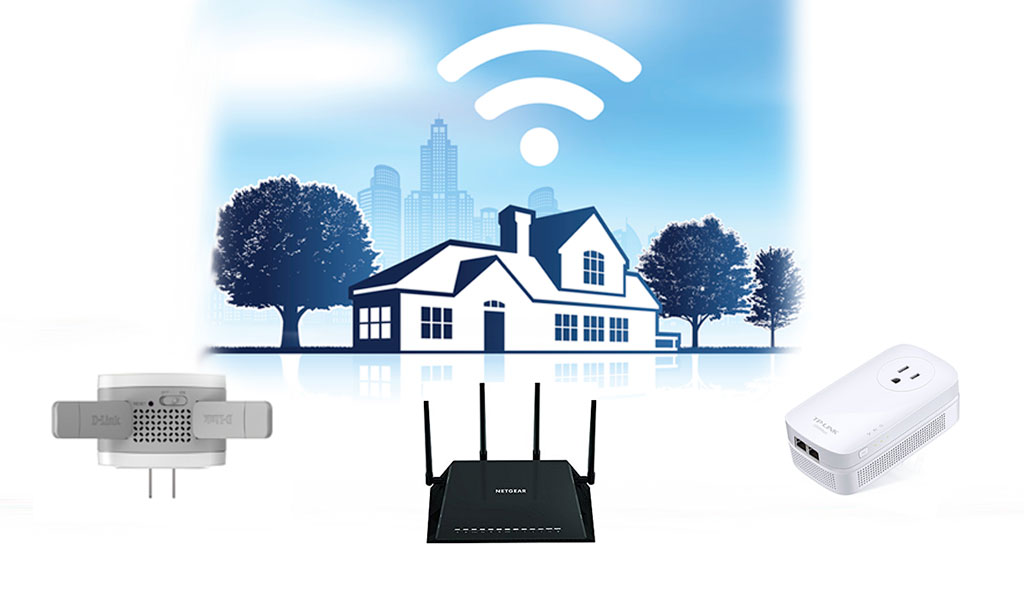How Much Internet Data Do You Need?
Try to get 1TB of internet data and 10GB of mobile data
Nov 19, 2025 | Share
Technology
You need at least 1TB of home internet data every month so everyone in your household can browse, stream, and game without a hitch. For your cell phone, you need at least 10GB of mobile data every month.
If you exceed your data cap, any of the following could happen:
- You could be charged for overages
- You could be cut off from the internet
- You could face severe speed slowdowns
We’ll give you a rundown of the data limits you can expect from your provider and help you find out how your internet speed impacts data usage. Then, we’ll give you tips on budgeting your data and recommend the best unlimited plans.
On this page:
Unlimited data | 1 TB data caps | Budgeting your data | Data and rural internet | Cellphone data | Data and hotspots | FAQ
On this page:
How much data does an average internet user consume per month?
The average internet user consumes 641GB per month on their home internet plan, according to a recent report from OpenVault, but the heaviest users gobble up 2TB—nearly four times more. Data usage can fluctuate wildly month to month, so we recommend giving yourself a nice buffer and choosing a home internet plan with at least 1TB of data.
For mobile data, the average smartphone in the U.S. ate through an average of 21.9GB per month at the end of 2024, but you can get away with a plan closer to 5GB or 10GB if you stay on Wi-Fi most of the time and disable mobile data on data-hungry apps like TikTok and YouTube.
What’s the difference between internet speed and internet data?
You can think of internet speeds like a pipe and data like gallons of water. The speed is the width of the pipe, while data is the total number of gallons that pass through the pipe during a given period of time.
In geek speak, data is measured in GB and TB (gigabytes and terabytes) while speed is measured in Mbps and Gbps (megabits per second and gigabits per second). There are eight megabits in one megabyte and 1,000 megabytes in a gigabyte, so an internet connection with a speed of 100Mbps can transmit around 45GB per hour.
Faster speeds use more data
If you have a fast internet plan, that means you have a big pipe that can pass several gallons (MB or GB of data ) at a time. So it makes sense that the faster your speed, the more data you’re likely to use.
Use our “How Much Internet Speed Do I Need?” tool to see whether you can reduce data usage—and save money—with a slower internet plan.
How much internet data you need
| Internet activity | Minimum recommended data per month |
|---|---|
| Streaming video in HD | 300GB |
| Making video calls on Zoom | 60GB |
| Running home security cameras | 30GB–300GB (depending on video resolution and frequency of activity captured by the cameras) |
| Online gaming | 30GB |
| Web browsing and checking email | 40GB |
| Streaming music or podcasts | 13GB |
Data from the Armstrong data calculator.
If you’re shopping for a new phone or internet plan, the first step is to get a list of providers in your area and find out what plans are available at your address. Here’s what you can expect from each type of service.
Fiber or DSL internet: Unlimited data (AT&T Fiber, Verizon Fios, Quantum Fiber)
Cable internet: Data that’s either unlimited (Spectrum) or capped at 1–1.28TB (Cox)
Fixed wireless (including 5G home internet): Soft data caps, which mean slow speeds if you exceed certain limits (T-Mobile 5G Home Internet)
Satellite internet: Speed tiers based on the amount of high-speed “priority” data you need every month (Starlink, Hughesnet, Viasat)
If you’re looking at options with strict data limits, figure out how much data you actually use. For home internet, you can find out by logging onto your router or looking at your monthly bill. For your cell phone, you can find on your monthly bill, on your provider’s mobile app, or on your device.
Home internet data monitoring
The easiest way to monitor your home internet data usage every month is to log in to your router’s mobile app. If you rent Wi-Fi gear from your provider, this will be your provider’s app. If you use your own router, you’ll probably have an app from the manufacturer. Look for “Activity” or “data usage” to find the relevant data. If you can’t find what you need there, your data usage may be listed on your monthly bill.
Monitoring cell phone data is easy on most devices, too. On iPhones, go to Settings. From there, search the list for Cellular. Then, find the “Usage” line to see both how much cellular data you’ve used and how much your plan offers. On Android phones, go to Settings, then look for either “Connections” Or “Network & Internet.” Look for Carrier, and then tap “Settings” to see data usage.
How to budget your internet data
If you can’t find a plan with unlimited data and you’re tired of either slowdowns or extra fees for exceeding your monthly data, you can go on a data budget. It sounds harsh, but it doesn’t have to be too painful if you learn some digital life lessons.

Pro tip:
Take a look at the best unlimited-data internet plans for the inside scoop on speeds, pricing, and availability.
Get unlimited data to avoid going over your data limit
Before we go further, let’s be clear about one thing. The best way to ensure you have all the data you need is to get an internet plan with unlimited data.
Unlimited data means you can use the internet all you want, without consequences (well, from your service provider at least).
Best internet plans with unlimited data
| Plan | Price | Speed | Order online |
|---|---|---|---|
| Google Fiber Core 1 Gig | $70.00/mo.* | 1,000Mbps | View Plans |
| T-Mobile Rely Home Internet | $50/mo.† w/ AutoPay, plus taxes & fees. | Up to 415Mbps | View Plan |
| Spectrum Internet Premier w/ Spectrum Advanced | $60/mo.‡ for 12 mos. | Up to 500Mbps (wireless speeds may vary) | |
| Astound 300 Mbps Internet | $20.00/mo.§ | 300Mbps | View Plans |
| Earthlink Fiber 1 Gig | $74.95/mo.║ | 1,000Mbps |
Data as of 11/14/2025. Availability and speed may vary by location, and prices are subject to change. See disclaimers.
Do you need unlimited data? Honestly, probably not.
But unlimited data does come in handy if you spend a lot of time doing online activities that use up lots of data, like streaming video and downloading large files.
Unlimited data is also useful if you share Wi-Fi with a lot of roommates or family members. If you go back to the water analogy—the more people you have on your Wi-Fi, the more data you consume overall. So you need a larger water tank to get through each month.
Looking for an internet plan with lots of data?
Search your zip code below to see what’s available in your area.
Is 1 TB of internet data enough?
For most households, 1TB of data is enough for a month of internet use. That’s the usual data cap for home internet providers, and it’s a generous amount. It will cover activities like browsing, checking email, and watching a handful of YouTube videos or Netflix movies every day.
However, it’s much easier to go through 1TB of data in 30 days if you have gigabit internet speeds, spend a lot of time doing data-heavy activities, share your Wi-Fi with a lot of other users, or all of the above.
These activities use a large amount of data:
- Streaming video
- Making video calls
- Running smart-home security cameras
- Posting video to social media
- Downloading games and large files
- Doing any of these tasks on multiple devices at the same time
These activities use a small amount of data:
- Checking, sending, and receiving email
- Using social media (without posting video)
- Browsing the web (with no video)
- Streaming music or podcasts
- Shopping online
Life lessons for consuming internet data
Lesson one: Stream video in standard definition to use less data
| Activity | Minimum recommended data per month | How much time it takes to use 1GB |
|---|---|---|
| Streaming video in SD | 500MB per hour | 2 hours |
| Streaming video in HD | 2GB per hour | 30 minutes |
| Streaming video in 4K | 8GB per hour | 7.5 minutes |
Data from the Armstrong data calculator.
If you’re worried about your data cap, it’s best to avoid watching video in 4K resolution—it gobbles up a stunning 8 GB per hour. (And can you really tell the difference between 4K and HD, anyway?) Even HD video can take a nasty bite out of your data. Streaming in SD lets you watch a lot more video without putting as big a dent on your data diet.
On most streaming apps, you can change video resolution by settings by logging into your profile on a PC or laptop browser.
Lesson two: Every file you download counts towards your data cap
| Download | How much data it uses |
|---|---|
| A six-page PDF | 5.9MB |
| An HD movie | Approx. 4GB |
| A video game or game update | Approx. 20-60GB |
Data from the Armstrong data calculator.
The size of a file you download roughly corresponds to the amount of data you use to download it. You can see how much data a download eats up by looking at how big the file is—the larger the file, the more data.
Lesson three: Watch out for video calls and smart-home cameras
| Activity | How much data it uses | How much time it takes to use 1 GB |
|---|---|---|
| Making a video call in SD | 340MB per hour | 3 hours |
| Making a video call in HD | 2GB per hour | 30 minutes |
| Running a smart home security camera | 2GB per hour | 30 minutes |
Data from the Armstrong data calculator.
High-resolution video calls on apps like Zoom have the potential to make a big dent in your monthly data. You probably don’t need to worry if you make a couple calls a day, but consider switching off the HD setting on your Zoom account if you work from home and regularly sit in on multiple daily meetings.
The same goes for smart home security cameras, which can use up to 2GB per hour depending on the resolution and other settings.
Lesson four: Don’t sweat the small stuff
| Activity | How much data it uses | How much time it takes to use 1 GB |
|---|---|---|
| Online gaming | 200MB per hour | 5 hours |
| Web browsing | 180MB per hour | 5-6 hours |
| Scrolling/posting on social media | 90MB per hour | 10-11 hours |
| Streaming audio | 60MB per hour | 18-19 hours |
| Sending/receiving emails | 40MB per 100 emails | 2,500 emails |
Data from the Armstrong data calculator.
You don’t use much data sending emails, reading the news, scrolling social media, shopping online, or streaming music and podcasts. Even online gaming has a relatively modest impact on your data cap. If this constitutes the bulk of what you do online, then a 1TB data cap is plenty.
Ready for data without limits?
If you’re looking for fast internet with all-you-can-eat data, run your zip code below to see what’s available in your area.
With rural internet, you get a lot less data than usual
Many rural parts of the United States have limited internet options. Sometimes, the only service you can get is satellite or fixed wireless internet. Even if your provider says there are no data caps, your speeds could slow down dramatically if you exceed certain limits.
Does satellite internet have low data caps?
Each of the big three satellite internet providers now advertise unlimited data, but there’s more to the story. With Hughesnet, you get up to 200GB of priority data (depending on your plan) and then get deprioritized to standard data for the rest of the month. That can mean speeds that are really slow.
Viasat and Starlink offer unlimited data, but the real-world differences in speed are enormous. With Viasat, our proprietary speed test shows average results of 14.93Mbps. That’s barely fast enough to stream one video in SD without buffering. With Starlink, on the other hand, our speed test shows average results of 48.49Mbps. That’s fast enough for multiple connected devices, even if you don’t spring for a priority plan.
Why does fixed wireless internet have low data caps?
Fixed wireless sometimes has low data caps because bandwidth is limited by the number and proximity of local towers and the availability of radio wave spectrum. Rise Broadband, for instance, offers a 50 Mbps Internet plan with a 250 GB monthly cap, for instance. Rise Broadband charges you if you go over your data limit every month, but you can spring for its unlimited data plan upfront for an extra $25 each month. We recommend going that route rather than risking even more excessive overage charges.
5G Home internet plans from T-Mobile, Verizon, and AT&T offer unlimited data but it’s always deprioritized compared to mobile phone traffic and could be slowed if you exceed data limits outlined in fair use policies from each company.
How much cell phone data do you need?
The average smartphone eats through about 22GB of data every month, but you won’t need that much if you spend most of your time on Wi-Fi. If that’s you, look for a plan with about 10GB of data per month. That way, you can rely on your cell phone for social media, video calls, streaming, and other internet activities when you’re out and about.
If you can’t log onto a Wi-Fi network in places where you spend a lot of time (home, work, or school), you should get a plan with more data. Check your current cellular data usage for a ballpark estimate.
Although many cell phone plans tout “unlimited” data, in reality most of those plans have caps on high-speed data. The cap could be anywhere from 5GB to 100GB, depending on the plan, and when you go over, your speeds revert to crushingly slow, sub–1 Mbps speeds.
How much mobile data do you get from a hotspot?
You can get anywhere from 2GB to 100GB per month with your phone’s hotspot or a mobile hotspot.
Hotspots are a great tool if you spend a lot of time working outside your home or office. You can also use one if you’re house-sitting, traveling, or taking a short break at a vacation home. But they require data plans to work, and those plans usually come with strict limits. The data comes from a cellular network, which doesn’t have the same throughput capacity as a residential fiber, cable, or DSL internet network.
Even when you can get unlimited data on a hotspot, watch out for caveats. T-Mobile, Verizon, and AT&T technically give you unlimited hotspot data, but your plan comes with a set amount of premium, high-speed data for the month.
After that’s all used up, you get unlimited data at slow-creeping speeds that aren’t good for much. The phone plan from Visible, meanwhile, promises unlimited hotspot data, but only at 5 Mbps with just one Wi-Fi device connected at a time.

Pro tip:
Get more details on these hotspot data offerings in our guide to the best hotspot data plans.
FAQ about how much data you need
How much data do I need per month?
How much data do I use per month?
What is a data cap?
How much data do I need on my phone?
Disclaimers
Best internet plans with unlimited data
* Google Fiber Core 1 Gig
Plus taxes and fees. Upload/download speed and device streaming claims are based on maximum wired speeds. Actual Internet speeds are not guaranteed and may vary based on factors such as hardware and software limitations, latency, packet loss, etc.
† Spectrum Internet Premier w/ Spectrum Advanced
Limited time offer; subject to change; new residential customers only (no Spectrum services within past 30 days) and in good standing with Spectrum. Taxes and fees extra in select states. SPECTRUM INTERNET: Standard rates apply after promo period. Additional charge for installation. Speeds based on wired connection. Actual speeds (including wireless) vary and are not guaranteed. Services subject to all applicable service terms and conditions, subject to change. Not available in all areas. Restrictions apply.
‡ Astound 300 Mbps Internet
No contract required. 24 Month Internet Pricing. Equipment priced separately. Includes $5 discount w/ ebill & autopay. Observed speeds may vary. Excludes surcharges and fees. New residential customers only.
§§ Earthlink Fiber 1 Gig
with a 12 month contract. Actual speeds may vary depending on the distance, line-quality, phone service provider, and number of devices used concurrently. All speeds not available in all areas
|| T-Mobile All-In Internet
Guarantee exclusions like taxes and fees apply.
Author - Chili Palmer
Chili Palmer covers home tech services, with a special focus on understanding what families need and how they can stay connected on a budget. She handles internet access and affordability, breaking news, mobile services, and consumer trends. Chili’s work as a writer, reporter, and editor has appeared in publications including Telecompetitor, Utah Business, Idaho Business Review, Benton Institute for Broadband & Society, and Switchful.com.
Editor - Rebecca Lee Armstrong
Rebecca Lee Armstrong has more than six years of experience writing about tech and the internet, with a specialty in hands-on testing. She started writing tech product and service reviews while finishing her BFA in creative writing at the University of Evansville and has found her niche writing about home networking, routers, and internet access at HighSpeedInternet.com. Her work has also been featured on Top Ten Reviews, MacSources, Windows Central, Android Central, Best Company, TechnoFAQ, and iMore.





